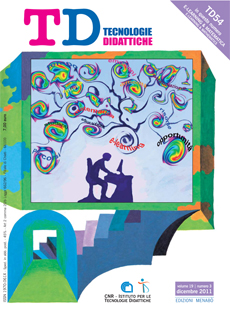Learning objects and personalized learning path in e-learning platforms
Main Article Content
Abstract
Article Details
Section
Authors who publish with this journal agree to the following terms:
- Authors retain copyright and grant the journal right of first publication with the work simultaneously licensed under a Creative Commons CC BY 4.0 Attribution 4.0 International License.
- Authors are able to enter into separate, additional contractual arrangements for the non-exclusive distribution of the journal's published version of the work (e.g., post it to an institutional repository or publish it in a book), with an acknowledgement of its initial publication in this journal.
- Authors are permitted and encouraged to post their work online (e.g., in institutional repositories or on their website) prior to and during the submission process, as it can lead to productive exchanges, as well as earlier and greater citation of published work (See The Effect of Open Access)
References
Albano G., D’Auria B., Salerno S. (2003). A WebMathematica application for Mathematics learning. In Sloot et al. (eds.). Proceedings of the Third International Conference on Computational Science, ICCS 2003 (Melbourne, Australia e St. Petersburg, Russia, 2-4 giugno 2003), 2657 (1). Berlin, Heidelberg: Springer-Verlag, pp. 754-763.
Artigue M. (1992). Didactic engineering. In R. Douady, A. Mercier (eds.). Research in didactique of mathematics: selected papers (special issue). Recherches en Didactique des Mathématiques, 12, pp. 41-65.
Balacheff N., Sutherland R. (1999). Didactical complexity of computational environments for the learning of mathematics. International Journal of Computers for Mathematical Learning, 4 (1), pp. 1-26.
Chevallard Y. (1985). La transposition didactique. Du savoir savant au savoir enseigné. Grenoble: La Pensée Sauvage.
Duval R. (2006). The cognitive analysis of problems of comprehension in the learning of Mathematics. Educational Studies in Mathematics, 61 (1), pp. 103-131.
Ferrari P.L. (2004). Mathematical language and advanced mathematics learning. In M. Johnsen Høines, A. Berit Fuglestad (eds.). Proceedings of the 28th Conference of the International Group for the Psychology of Mathematics Education (Bergen, Norvegia, 14-18 luglio 2004) 2, pp. 383-390. Cape Town, South Africa: International Group for the PME, URL: http://www.emis.de/proceedings/PME28/RR/RR177_Ferrari.pdf (ultima consultazione settembre 2011).
Gaeta M., Orciuoli F., Ritrovato P. (2009). Advanced ontology management system for personalised e-learning. Knowledge-Based Systems– Special Issue on AI and Blended Learning, 22, pp. 292–301.
NCTM (2000). Principles and standards of school mathematics. URL: www.nctm.org/uploadedFiles/Math_Standards/12752_exec_pssm.pdf (ultima consultazione settembre 2011).
Rav Y. (1999). Why do we prove theorems?. Philosophia Mathematica, 7 (3), pp. 5-41.
Skemp R.(1976). Relational understanding and instrumental understanding. Mathematics Teaching, 77, pp. 20-26.
Way J. (2004). Multimedia learning objects in mathematics education. Proceedings of ICME 10, URL: http://www.icme-organisers.dk/tsg1 /Way.pdf (ultima consultazione settembre 2011).
Wiley D. A. (2000). Connecting learning objects to instructional design theory: a definition, a metaphor, and a taxonomy. In D. A. Wiley (ed.). The instructional use of learning objects. Bloomington, In, USA: Association for Educational Communications and Technology. URL: http://reusability.org/read/chapters/wiley.doc (ultima consultazione settembre 2011).

